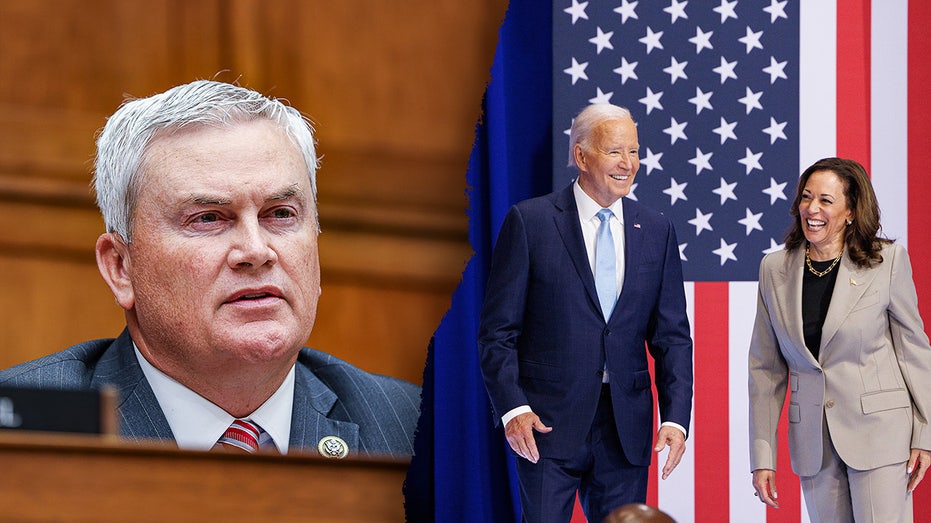Wait — do Harris and Trump actually agree on fracking?
In her first run for president during the Democratic primary, Kamala Harris said “There’s no question I’m in favor of banning fracking” during a 2019 town hall. Then, when she was running to be Joe Biden’s vice president in the 2020 campaign, Harris pushed back firmly when accused by then-Vice President Mike Pence of wanting […]


In her first run for president during the Democratic primary, Kamala Harris said “There’s no question I’m in favor of banning fracking” during a 2019 town hall.
Then, when she was running to be Joe Biden’s vice president in the 2020 campaign, Harris pushed back firmly when accused by then-Vice President Mike Pence of wanting to ban hydraulic fracturing during a debate.
“First of all, I will repeat, and the American people know, that Joe Biden will not ban fracking,” Harris said. “That is a fact. That is a fact.”
Since taking office, the Biden-Harris administration upheld that promise, and Harris has held the line. “What I have seen is that we can grow and we can increase a thriving clean energy economy without banning fracking,” Harris told CNN.
Hydraulic fracturing, aka fracking, is the main method of producing oil and gas in the United States. It involves pumping highly pressurized water, sand, and other chemicals into rock formations to create fractures that release trapped oil and gas.
The fracking boom has radically reshaped the US energy portfolio over the past two decades. Last year the US produced more oil and gas than any country, ever.

Biden even reneged on a campaign promise not to allow more oil and gas drilling on public lands, approving one of the largest oil developments in Alaska. He also signed off on a major new natural gas pipeline.
Though the administration has been eager to take credit for the US’s soaring energy production and for keeping a lid on gasoline prices, this hydrocarbon bounty is undermining Biden’s climate change goals: curbing greenhouse gas emissions by 50 to 52 percent relative to 2005 levels by 2030 and zeroing out emissions across the economy by 2050.
Meanwhile, the Republican presidential nominee Donald Trump spent his last term in office undoing environmental regulations and has pledged to push for even more fossil fuel development if he wins the presidency again in November.
Natural gas from fracking burns more cleanly than coal, and as it’s become the largest source of electricity in the US, it has helped push down US greenhouse gas emissions even as the economy has grown. But natural gas is still a fossil fuel, and burning it worsens climate change. The more new fracking wells, pipelines, gas power plants, and liquefied natural gas export terminals go up, the longer the US will remain committed to this fossil fuel. Earlier this year, the White House paused approvals of new export facilities for natural gas, but even with the delay, US natural gas exports are poised to double by 2030.
Fracking also raises other environmental concerns. Wastewater injection from fracking wells has caused a spike in earthquakes. It has led to local air quality and safety problems. Some gas wells have leaked methane, a potent greenhouse gas.
For policymakers, the difficult choice is deciding whether the benefits outweigh the harm, and if fuels from fracking can be a stepping stone toward cleaner energy. “This is one of those issues where there’s just so much gray,” Sam Ori, executive director of the Energy Policy Institute at the University of Chicago, told Vox previously. “I don’t think that there’s a really clear case that says fracking is necessarily good or bad, on net.”
And for presidential candidates, it’s tough to find the right pitch to voters, who are themselves divided. Pennsylvania, a critical swing state in the presidential election and the launch site of the modern fracking boom, is the second-largest natural gas producer in the US behind Texas. Yet it has mixed levels of support for fracking, and northeastern Pennsylvania voted to ban fracking in the region.
The debate about fracking is also a microcosm of a broader question of the role of fossil fuels in the transition toward cleaner energy, whether they should be fought as an adversary or embraced as a partner. When Biden leaves the White House next year, he will leave behind a legacy of the most aggressive actions to address climate change ever, as well as a massive expansion of fossil fuels.
The US is now facing two radically different courses on the environment depending on who wins in November. However, since neither of the major presidential candidates say they want to ban fracking these days, it’s unlikely there will be any federal restrictions in the coming years. On the other hand, states like California and New York are working to halt or restrict the practice, and more may join the list.
But as the current presidential candidates spar over the role of fracking, there remains a lot of debate over whether the practice is a net good for the end environment, and if it should be banned.
The best case in favor: Fracking has reduced greenhouse gas emissions and helped expand clean energy
Though hydraulic fracturing as a technique has been around since the 19th century and the first commercial fracking for gas took place in the 1940s, the most recent fracking boom started in earnest around 2005. That’s when the rising prices of oil and gas forced energy companies to look for other sources, when related techniques like horizontal drilling and low-cost slickwater fracking matured, and new estimates revealed the gargantuan amounts of gas stored in formations like Marcellus Shale, spanning Pennsylvania and New York.
Fracking has now become the dominant technique for extracting oil and gas in the US.

Fracking arose against the backdrop of the United States’ massive carbon footprint. The US is responsible for the highest share of cumulative global greenhouse gas emissions of any county. Currently, it’s the second-largest emitter in the world, behind China. It also has some of the highest per capita emissions in the world.
Scientists have warned that if humanity wants to limit warming this century to 1.5 degrees Celsius above pre-industrial levels, countries would need to cut global emissions in half or more from current levels by as soon as 2030 and reach net-zero emissions by 2050.
During much of the fracking boom, the US economy grew and emissions declined. One study found that between 2005 and 2012, fracking created 725,000 jobs in the industry, not counting related supporting jobs. “This has been one of the most dynamic parts of the U.S. economy — you’re talking about millions of jobs,” Daniel Yergin, vice chairman of IHS Markit and founder of IHS Cambridge Energy Research Associates, told CNBC.
That’s largely due to natural gas from fracking displacing coal in electricity production. Natural gas emits about half of the greenhouse gas emissions of coal per unit of energy. It doesn’t have the massive land footprint that open pit mines or mountaintop removal coal mines do. While it has its own pollution problems, burning natural gas doesn’t produce pollutants like ash and mercury, which can pose health and environmental hazards for years.

“Regardless of what you believe about the future, shale gas has played a substantial role in getting rid of carbon emissions and conventional emissions from coal,” said Ori.
A report from the Breakthrough Institute titled “Coal Killer” explained that coal-fired power generation declined from producing 50 percent of US electricity in 2007 to 16 percent in 2023. Natural gas from fracking largely rose to fill that void.
The main reason for this shift is that fracked natural gas is cheaper than coal for the energy it produces. That makes it attractive for utilities, especially in competitive markets. Many natural gas power plants use combined-cycle gas turbines. Not only do they produce 50 percent more energy for the same amount of fuel compared to a single-cycle turbine, they can spool up quickly to meet surges in demand or shortfalls from other power producers. Compared to coal and nuclear power plants that have a harder time ramping up and down, this added flexibility makes natural gas power plants particularly valuable on the grid.
Even the newest, cleanest, more efficient coal-fired power plants struggle to compete with natural gas.
Natural gas’s flexibility has also eased the integration of variable renewable energy sources like wind and solar power. When the breezes slow down and clouds form above, natural gas steps in. This has reduced the need for other ways to compensate for intermittency, like energy storage.
In fact, as fracking has grown in the US, renewable energy generation has doubled since 2008. Renewables, including hydropower and biomass, now comprise just over 21 percent of total US electricity generation. Coupled with nuclear power, about 19 percent of the electricity mix, that still leaves nearly two-thirds of power generation that needs to decarbonize. And that will take years.
So fracked natural gas’s record as a coal slayer and renewable energy booster makes it a valuable weapon in the fight against climate change.
“If you’re talking about natural gas as a decarbonizing fuel while replacing coal, I think the facts on the ground really support that,” said Alex Trembath, a coauthor of the “Coal Killer” report and deputy director at the Breakthrough Institute. “We’ve actually seen significant growth in solar and wind in particular even alongside the fracking revolution.”
At the same time, fracking has helped insulate the US from global economic shocks, particularly in oil markets. US shale oil has provided more than half the growth in global oil supplies, so rising tensions and disruptions in countries like Russia, Iran, Libya, and Venezuela have barely moved the needle at the gas pump.
Fracked natural gas’s record as a coal slayer and renewable energy booster makes it a valuable weapon in the fight against climate change.
“The oil price impacts of those big disruptions have been pretty muted and a lot of that has to do with the incredible growth of shale oil as a source of new supply in the global market,” Ori said. US natural gas has also helped countries in Europe wean themselves off of Russian natural gas after Russia stepped up its invasion of Ukraine.
In short, natural gas obtained by fracking has reduced emissions, aided the economy, and helped clean energy rise, while costing less than dirtier fuels.
The best case against: Fracking keeps us dependent on fossil fuels and undermines decarbonization
Both the oil and natural gas produced from fracking have their downsides. Natural gas is mainly used for power generation (it’s now the largest source of electricity in the US) while oil is mostly used for transportation, like cars, shipping, and aviation.
So while low natural gas prices have helped knock dirty coal off the market, low oil prices driven in part by fracking have encouraged more travel. In fact, transportation is now the largest source of greenhouse gases in the US.
Low oil prices have undermined the business case for cleaner transportation alternatives, like electric cars and fuel cell-powered buses. Instead, the United States has experienced a growing appetite for larger, thirstier cars and more air travel.
Meanwhile, low natural gas prices have had some collateral damage for nuclear power, the largest source of clean electricity in the US. Some of the nuclear power plants that have announced early retirements are likely to see their capacity replaced by natural gas. So while replacing coal with natural gas often leads to a reduction in emissions, replacing nuclear energy leads to an increase.
Natural gas itself can also become a climate problem. Methane, the dominant component of natural gas, produces less carbon dioxide than coal when burned. But if methane leaks, which it often does in some quantity during normal gas extraction operations, it becomes a potent greenhouse gas. Over 100 years, a quantity of methane traps more than 25 times the amount of heat compared to a similar amount of carbon dioxide.
Of course, methane is the product (and it’s flammable), so the gas industry has an incentive to limit leaks. But leaks are difficult to track, and they could easily overwhelm the gains from replacing coal.
Robert Howarth, a researcher studying shale gas at Cornell University, reported that US shale gas production plays an outsized role in global methane emissions. He estimated that over the past 10 years, more than half of the global increase in methane emissions came from fracking in the US.
“Natural gas production in the United States is leaking somewhere in the neighborhood of 3.5 percent of the gas we produce into the atmosphere which is, you know a relatively small amount of gas if you think about it. Most of it is getting to market,” Howarth said. “But that 3.5 percent is enough to do severe damage to the climate.”
This is a higher leakage estimate than the EPA and the industry calculate, and some researchers have criticized Howarth’s methodology, but the calculation played an important role in the Biden administration’s decision to pause natural gas exports.
And then there’s the technique of fracking itself. It requires a massive volume of water. Wells can release toxic chemicals like benzene into the air. Fracking sites can experience explosions and fires. They can contaminate drinking water. More than 17 million people in the US live within a mile of an active fracking well, and research shows that fracking can lead to low birth weight in infants born in that radius.
Many of these environmental risks, on balance, are less than those associated with mining and burning coal. However, the sudden surge in fracking means many people are being confronted with its impacts for the first time, making it a more vivid political concern. That’s in contrast to coal hazards, which are mostly familiar to the public consciousness.
Another factor is that the business case for fracking could weaken as renewables improve. The Rocky Mountain Institute estimates that clean energy is already competitive with new natural gas power plants, and by 2035, it will be cheaper to build new wind, solar, and storage projects than to continue running 90 percent of existing gas power plants.
And when it comes to limiting climate change, a key factor is time. Methane leaked from gas wells can stay in the atmosphere for a decade. Carbon dioxide from burning it can linger for a century. So it is imperative to ramp down greenhouse gas emissions as quickly as possible. Yet every new natural gas power plant represents a decades-long commitment to continue using the fuel. That means gas plants will have to install carbon capture systems, which would add to their operating costs and worsen the business case further, or some poor investor is going to be left holding the bag.
What a president can actually do about fracking
Though Democrats have dialed down some of their messaging on climate change and Republicans scarcely talk about it all, energy policy is a perennial presidential campaign issue. President Obama often boasted about the rise of the United States as an energy giant. President Trump pushed to leverage US oil and gas in order to exert energy dominance. And President Biden spurred the US to become the largest oil and gas producer in the history of the world.
In the current campaign, Trump continues to falsely accuse Harris of wanting to ban fracking. But how much can a president actually do to curb fracking on their own? It turns out that the executive doesn’t have a lot of direct levers over fossil fuel extraction without Congress.
The federal government can limit export licenses for oil and natural gas, as Biden has done. It can also make it more difficult to mine and drill on public lands. However, a lot of the energy policy in the United States is governed at the state and local level, so the White House can’t easily shape the agenda without local backing.
The federal government can also regulate the pollution from vehicles and power plants that contributes to climate change. As these regulations ratchet up, dirtier forms of energy become more expensive and cleaner alternatives start to look more appealing.
Breakthrough’s Trembath argued that a president would best be served by building an off-ramp for the bridge away from fracking, rather than cutting it off. It would be less disruptive and contentious and would allow the country to continue harnessing the benefits of fracking while coming up with better options. The Biden administration has attempted this with legislation like the Inflation Reduction Act to accelerate clean energy sources and deploy the infrastructure for electric vehicles. “The first way we hasten the end of the bridge is to make the [alternative] technology cheaper,” he said.
Update, September 5, 2024, 3:40 pm ET: This story was originally published in 2019. It has been updated now to reflect the discussion of a fracking ban during the 2024 presidential election.















